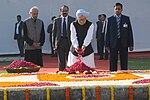|
Raj Ghat and associated memorials
Raj Ghat is a memorial complex in Delhi, India. The first memorial was dedicated to Mahatma Gandhi where a black marble platform was raised to mark the spot of his cremation on 31 January 1948 and consists of an eternal flame at one end. Located on Delhi's Ring Road, a stone footpath leads to the walled enclosure that houses the memorial. Later the memorial complex was expanded to include memorials for other prominent Indian leaders including Jawaharlal Nehru, Lal Bahadur Shastri, Indira Gandhi, Rajiv Gandhi, Chandra Shekhar and Atal Bihari Vajpayee. EtymologyRaj Ghat loosely translates to Royal Steps with the word "royal" alluding to the importance of the place and "steps" referencing the climb from the banks of the Yamuna river.[1] LocationRaj Ghat was the name of a location of historic ghat in Shahjahanabad in Old Delhi on the west bank of the Yamuna River east of Daryaganj.[2] List of memorialsThe first memorial was dedicated to Mahatma Gandhi on the spot where his remains were cremated on 31 January 1948. It consists of a black marble platform with an eternal flame at one end. A stone footpath leads to the walled enclosure that houses the memorial. Later the memorial complex was expanded to include several other samadhis for various leaders in the vicinity of Raj Ghat. The landscaping and planting of these memorials were originally performed by Alick Percy-Lancaster, Superintendent of Horticultural operations with the Government of India.[3][4][5][6] In 2000, the government of India under Atal Bihari Vajpayee took a decision to not create separate memorials for different leaders as the already existing memorials were occupying more than 245 acres of prime land in Delhi.[7]
ControversiesThe hard materials used in the memorial had raised a few questions about the nature of Gandhian architecture where there is a stark difference between the architecture of Rajghat and a Gandhian low-cost housing architecture.[8] P. V. Narasimha Rao was the ninth Prime minister of India. He died on 24 December 2004 at the All India Institute of Medical Sciences in Delhi.[9] His family wanted the body cremated at Raj Ghat in Delhi. In 2015, almost ten years since his death, a memorial was finally erected at Gyan Bhumi.[10] References
External linksWikimedia Commons has media related to Rajghat. |
||||||||||||||||||||||||||||||||||||||||||||||||||||||||||||||||||||||||||||||||||||||||||||||||||||||||||||||||||||

















